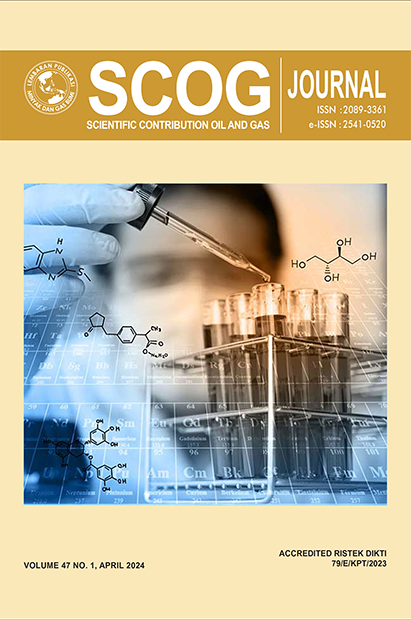Seismic Data Processing and Seismic Inversion in The Ray Parameter Domain: Common Reflection Point (CRP) Stack and Ray Impedance
DOI:
https://doi.org/10.29017/SCOG.47.2.1621Keywords:
acoustic impedance, elastic impedance, ray impedanceAbstract
Reservoir characterization can be enhanced by integrating lateral and vertical perspectives from seismic surveys and well logging, respectively. Seismic impedance is a crucial parameter, calculated by multiplying the rock density by the primary (P) wave velocity. While acoustic impedance solely considers these two factors, elastic impedance incorporates additional angular measurements and secondary (S) wave velocity data. Elastic impedance, however, equates the incident angle with the transmission angle in disregard of Snell's law; therefore, it provides a simplified representation of seismic impedance. This study explores an alternative approach to seismic impedance, known as ray impedance. We calculated ray impedance by tracing the impedance variation along the path of a seismic ray, considering its changing velocity and angle as it traveled through different subsurface strata. We transformed the seismic information from the offset space to the ray parameter space, to achieve ray parameter stacking. Unlike the traditional angle domain inversion, which uses near-angle, mid-angle, and far-angle seismic stack data, the ray-impedance inversion utilized segments of ray data: near-ray, mid-ray, and far-ray. We compared the common depth point stack, ray stack, and angle stack methods to infer the acoustic, elastic, and ray impedance characteristics. Challenges with gas cloud interference in seismic data imaging were present. We developed a ray parameter strategy to address these imaging difficulties. The comparison of different stacking techniques indicated that ray stacking could offer an alternative for imaging in the presence of gas cloud effects. Furthermore, impedance cross-plotting demonstrated that ray impedance provided a more discernible separation of low-clay-content zones than elastic impedance did. Overall, data processing in the ray parameter domain yielded positive imaging outcomes in the presence of gas clouds, suggesting that ray impedance is a practical method for lithological differentiationReferences
Aki, K., and Richards, P. G., 1980, Quantitative seismology: theory and methods: W.H. Freeman.
Avseth, P., T. Mukerji, and G. Mavko, 2005, Quantitative seismic interpretation: Cambridge University Press.
Connolly, P., 1999, Elastic impedance: The Leading Edge, 18, 438-452.
Lu, X., 2010, Seismic Ray Impedance Inversion, 23- 50, a Thesis: Imperial College London.
Rutherford, S. R., and R. H. Williams, 1989, Amplitude-versus-offset variations in gas sands: Geophysics, 54, 680–688.
Sinaga, E., Triyoso, W., Oktariena, M., 2018, Comparative Study of Seismic Impedance in Ray Parameter Domain: Case Study of Seismic Imaging and Seismic Inversion in Gas Cloud Zone, Proceedings of the 13th SEGJ International Symposium, 2018.
Tarantola, A., 1986, A strategy for nonlinear elastic inversion of seismic reflection data: Geophysics, 51, 1893-1903.
Triyoso, W., Oktariena, M., Sinaga, E., and Syaifuddin, F., 2017, Full Waveform Modelling for Subsurface Characterization with Converted- Wave Seismic Reflection, IOP Conference Series: Earth and Environmental Science, 62.
Triyoso, W., Oktariena, M., Muhtar, L. K., 2018, Ray-Binning Angle Stack Domain in Enhancing the Robustness of Converted-Wave Seismic Joint Inversion, Scientific Contributions Oil and Gas Vol. 41, No 3, 2018.
Triyoso, W., Irawan, J. B., Viony, N. C., Fatkhan, 2020, Application of ZO-CRS Stack on Residual PP Removal of PS Component in Converted- Wave Seismic Reflection Processing, Scientific Contributions Oil and Gas Journal, Vol. 43 No 2, 2020.
Triyoso, W., Supriyono, S., Akbar, F. S., Oktariena, M., Lestari, S., Yusuf B.E., Miraza, D., (2023), The 3D Seismic Survey Design of South Walio Offshore, Indonesia: Optimizing the 3D Survey Design Parameters, Scientific Contri- butions Oil and Gas Journal, Vol. 46 No. 2, 2023.
Wang, Y., 1999, Approximations to the Zoeppritz equations and their use in AVO analysis: Geophysics, 64, 1920-1927.
Wang, Y., 2017, Seismic Inversion: Theory & Application, 127-138, Wiley Blackwell.
Wang, Y., 2003, Multiple attenuation: coping with the spatial truncation effect in the Radon transform domain: Geophysical Prospecting, 51, 75-87.
Zhang., 2010, Joint Inversion of Seismic PP- and PS- Waves in the Ray Parameter Domain, Imperial College London, 1-22.
Downloads
Published
Issue
Section
License
Copyright (c) 2024 SCIENTIFIC CONTRIBUTIONS OIL AND GAS (SCOG)

This work is licensed under a Creative Commons Attribution 4.0 International License.
Authors are free to Share — copy and redistribute the material in any medium or format for any purpose, even commercially Adapt — remix, transform, and build upon the material for any purpose, even commercially.
The licensor cannot revoke these freedoms as long as you follow the license terms, under the following terms Attribution — You must give appropriate credit , provide a link to the license, and indicate if changes were made . You may do so in any reasonable manner, but not in any way that suggests the licensor endorses you or your use.
No additional restrictions — You may not apply legal terms or technological measures that legally restrict others from doing anything the license permits.














